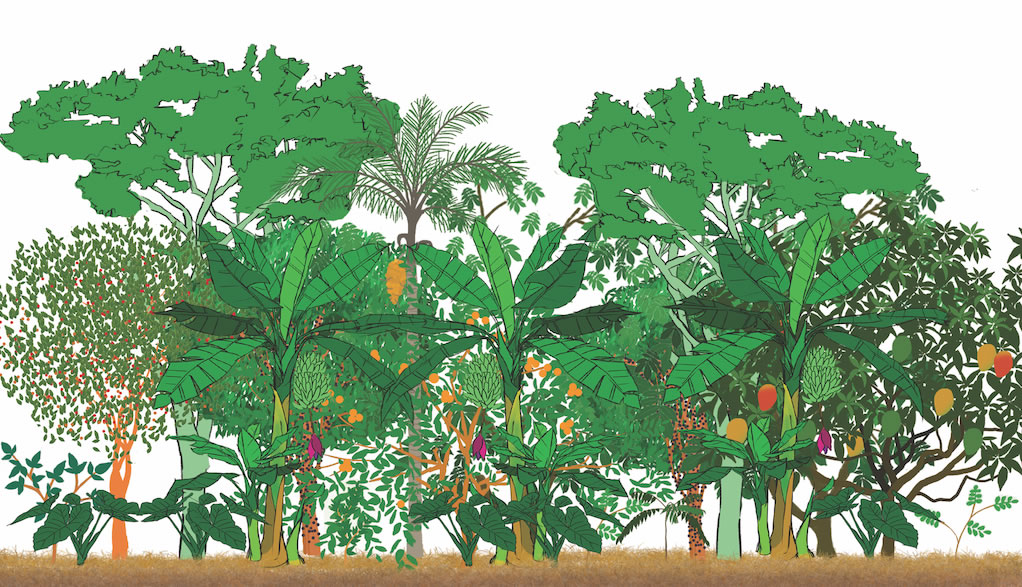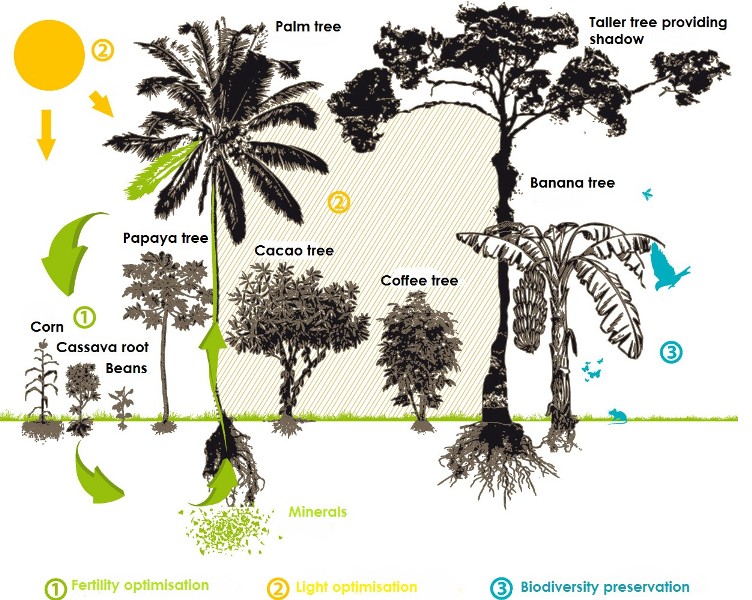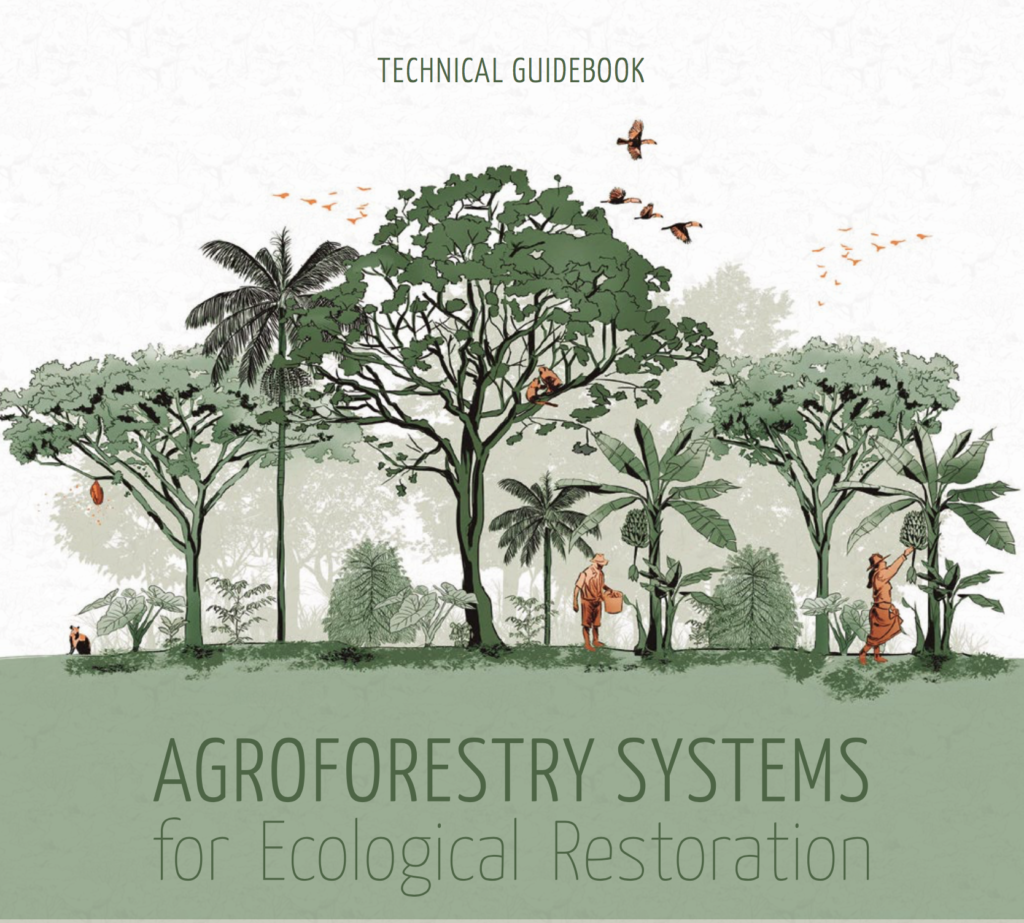Climate action – Climate justice
In our view Climate justice means equal chance for all actors (states, companies, NGO, people, native tribes) to take adaptive and mitigating measures in face of ongoing Climate change.

We support:
- actions to retain and protect water resources
- soil regeneration to keep water and nutrient cycles to
- regenerative agriculture in form of small family and community farms based on agroforestry. Agroforestry is composed of fruit trees and other crops which supports each other in form exchanging different nutrients. Nitrogen fixing plants can fix air nitrogen and change it into bio-nitrates which fertilize the soil. Falling leaves fertilize the ground and roots prevents soil erosion. Agroforestry system can be used even on deforested jungle for recovery so this is the reason why we promote its use in local communities. Agroforestry also create job opportunities and boosts local economies.
- reforesting of deforested areas
- protection of biodiversity. For example : intense fishing due to dense human populations creates pressure on number of fishes in rivers. There is less and less fishes in river every year and even their proportions are smaller and smaller. We support creating fish ponds to ease such a pressure so fish populations can regenerate.
All these actions in local areas helps to maintain its proper microclimate, water retention and water cycle, nutrients in soil and therefore healthy economies based on locally produced food and nature-based products ( for example bijao leaves for wrapping the food instead of plastic, carpentry from local wood instead of plastic products, local fruit drinks instead of soda drinks, local honey from bees instead of commercial sugar). In places where people take care about nature, nature take care about people which means that these healthy, stable and rich ecosystems provide necessary ecosystem services for local human populations like clean water, rich soil, local food, necessary nature products like wood for housing and carpentry, ceramics, biofertilizers, textiles, dyes, plant medicine, oils, cosmetic products, materials for handicrafts. We propose and realize this vision of mutual symbiotic relationships between people and nature instead of simple exploitation.

Education and support for local communities
We provide:
- education and support for local communities in for implementing agroforestry systems instead of slash-and-burn agriculture.
- education system of beekeeping of bees for honey production
- education and system of fish ponds
- education about growing and use of plant medicine
In many jungle communities you see lot of pressure for acculturation which often end up in loss of local traditions, skills, customs and even languages. It is paradox but you can often see communities in jungle which do not grow their food at all. Lot of local people just rely on occasional income from tourism and buy food and commercial products in city to emulate “civilized” lifestyle. In times not long ago there was tradition of “ la minga” the communal work which was not based on payment with money for work, but instead of exchange of work, and when everyone rotates in their deeds, necessities of whole community were maintained (like house construction, agriculture work like seeding, and harvest). Now “la minga” is very often but a distant memory and all services must be payed because trust between people has diminished. Local people often do not have enough of available money and for that reason it is not possible to work the land so people do not work the land even if they are owner of large landscapes.
We work in community workshops to revive trust and motivate people to integrate system of “la minga” in their lives again so they will be able to work the land and and make autonomous food-producing systems.
We would like to present this technical manual with details for interested people. Here you can find many details about agroforestry and practical informations and experience with implementing these systems in practise. We do not support incorporation of cattle farming into agroforestry, even not cattle farming itself because it has very often detrimental consequence for surrounding nature and jungle ending in deforestation.

Andrew Miccolis and collective
Source: http://apps.worldagroforestry.org/ … /B19034.pdf
Support for tradition of plant medicine
Tradition of plant medicine stems from native shamanism, part of that tradition transformed into mestizo shamanism and plant medicine knowledge which is known as Vegetalismo. This tradition is about 150-200 years old.
In order to preserve these traditions the knowledge and skills must be passed from generation to generation. This processed is now weakened of even endangered because young generation do not have the same interest in tradition or plant medicine as their ancestors and also training and apprenticeship is very long (about 5-7 years) demanding, hard and challenging requiring strong will and rigorous discipline.
We support interest, motivation and education of young people in field of plant medicine in workshops to demonstrate and teach various medicinal properties of medicinal plants not only in curing actual diseases but also in field of preventing them. Local healers will find their future students in this process but it needs time and patience.
We also support planting plant medicine gardens in communities so medicinal plants are available there for education and practical use.
Support of Amazonian art
There is famous part of Amazonian art which is concentrated on depiction of ayahuasca vision, worlds and mystical knowledge. First painter was Pablo Amaringo ( 1938 – 2009 ) who started this distinct style of its own art and founded his own art school Usco Ayar in Pucallpa He had many students who continue this way of art.
Amazonian art or neo-Amazonian art ( which is modern form evolving from its original form) needs wider attention, support and recognition so the artists will able to transmit their skill to younger students – this needs time, patience and lot of attention much like teaching about plants. Only when artists can make their own livelihood they can find time and space to teach their students few hours every days. For this thing they need support in form of people buying their paintings or art workshops. We support two such artists, direct students of Pablo Amaringo: Ener Diaz Nuňéz and Mauro Réategui Perez. We are exhibiting their art in gallery in our hostal (there is no art gallery in Iquitos), showing their galleries of art in our website and also offering art workshop for interested people.
Support of Cocama tribe
We support Cocama tribe in community Padre Cocha (Iquitos). We provide education about agroforestry, plant medicine and their cooperation with our participative ecotourism programme helps their youngs and children to exercise their own native skills, knowledge and wisdom so they will not loose their customs and tradition like it happened in many other places around. Economic help also help them to buy more land where they can be sovereign owners. Cocama tribe is active in keeping their native Cocama language alive so it will be not forgotten.
Ayahuasca species conservation Reserve
We have founded Ayahuasca species conservation Reserve for more than ten ayahuasca species to conserve their genetics, and to teach and learn about growing their populations and keeping alive knowledge of their diverse medicinal use so it will not disappear.
This rare collection of ayahuasca species is unique not only in Peru, but in whole South America.
Due to overharvesting ayahuasca species are more scarce and its dwindling numbers can affect their genetics, reproduction and ecology. Among local people and even healers certain knowledge regarding recognition of species, their medicinal properties and use are disappearing so we conserve not only the ayahuasca species but whole complex knowledge of their medicinal use.